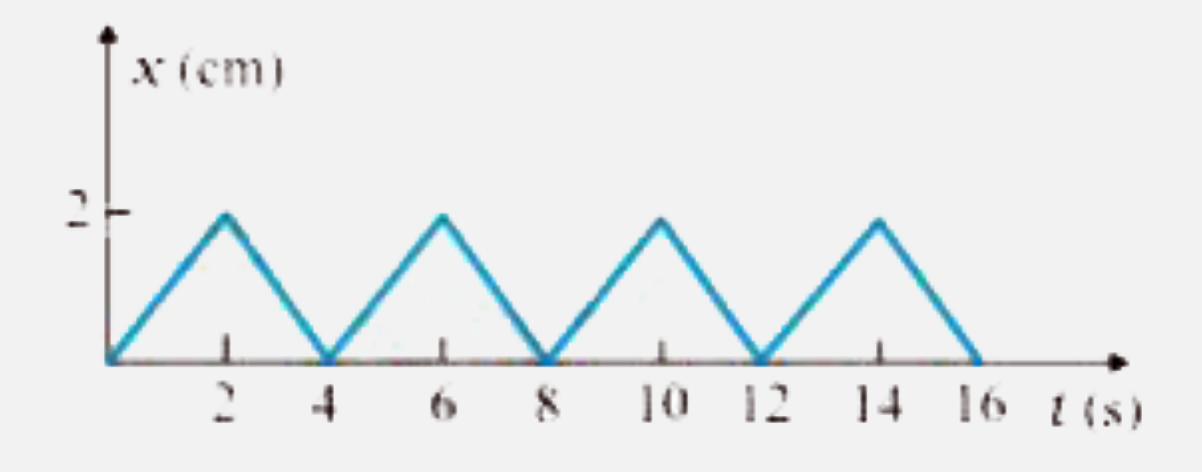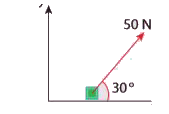A body of mass 0 .40 kg moving initially with a constant speed of 10m/s to the north is subjected to a constant force of 8.0 N directed towards the south for 30 s Take the instant the force is applied to be t = 0 , and the position of the particle at that time to be x = 0 , predict its position at t=−5s,25s,100s ? Solution in Tamil
a=−20ms−20≤t≤30s
t=−5s:x=ut=−10×5=−50m
t=25s:x=ut+(1/2)at2=(10×25−10×625)m=−6km
t = 100 s : first consider motion upto 30 s
x1=10×30−10×900=−8700m
At t=30s,v=10−20×30=−590ms−1
for motion from 30s to 100s : x2=−590×70=−41300m
x=x1+x2=−50km
Topper's Solved these Questions
- LAW OF MOTIONBook:NCERT TAMILChapter:LAW OF MOTIONExercise:EXERCISE (ADDITIONAL EXERCISE)
Explore 17 Videos
- LAW OF MOTIONBook:NCERT TAMILChapter:LAW OF MOTIONExercise:EXERCISE (ADDITIONAL EXERCISE)
Explore 17 Videos
- KINETIC THEORY OF GASESBook:NCERT TAMILChapter:KINETIC THEORY OF GASESExercise:EVALUATION (Numerical Problems)
Explore 8 Videos
- LAWS OF MOTIONBook:NCERT TAMILChapter:LAWS OF MOTIONExercise:EXERCISE (V. Numerical Problems)
Explore 14 Videos
Similar Questions
Figure shows the position-time graph of a body of mass 0.04 kg. Suggest a suitable physical context for this motion. What is the time between two consecutive impulses received by the body ? What is the magnitude of each impulse ?

View SolutionFigure shows the position-time graph of a body of mass 0.04 kg. Suggest a suitable physical context for this motion. What is the time between two consecutive impulses received by the body ? What is the magnitude of each impulse ?

View SolutionA fresh air is composed of nitrogen N2(78%) and oxygen O2(21%). Find the rms speed of N2 and O2 at 20∘C.
View SolutionA force of 50N act on the object of mass 20 kg. shown in the figure. Calculate the acceleration of the object in x and y directions

View SolutionA body of mass 0 .40 kg moving intially with a constant speed of 10m/s to the north is subjected to a constant force of 8.0 N directed towards the south for 30 s Take the instant the force is applied to be t = 0 , and the position of the particle at that time to be x = 0 , predict its position at t=−5s,25s,100s ?
View SolutionA body of mass m, moving along the positive x direction is subjected to a resistive force F=Kv2 (where K is a constant and v the particle n velocity). If m=10kgv=10m/s at t=0, and K=2N(m/s)−2 the velocity when t=2s is:
View Solutionउत्तर दिशा की ओर 10ms−1 की एकसमान आरम्भिक चाल से गतिमान 0.4 किग्रा संहित के किसी पिण्ड पर दक्षिण दिशा के अनुदिश 8.0 N का स्थायी बल 30 s के लिए आरोपित किया गया हैं । जिस क्षण बल आरोपित किया गया उसे t = 0 तथा उस पिण्ड की स्थिति x = 0 लीजिए । t = (-5) s पर इस कण की स्थिति क्या होगी ?
View Solutionउत्तर दिशा की ओर 10ms−1 की एकसमान आरम्भिक चाल से गतिमान 0.4 किग्रा संहित के किसी पिण्ड पर दक्षिण दिशा के अनुदिश 8.0 N का स्थायी बल 30 s के लिए आरोपित किया गया हैं । जिस क्षण बल आरोपित किया गया उसे t = 0 तथा उस पिण्ड की स्थिति x = 0 लीजिए । t = 25 s पर इस कण की स्थिति क्या होगी ?
View Solutionउत्तर दिशा की ओर 10ms−1 की एकसमान आरम्भिक चाल से गतिमान 0.4 किग्रा संहित के किसी पिण्ड पर दक्षिण दिशा के अनुदिश 8.0 N का स्थायी बल 30 s के लिए आरोपित किया गया हैं । जिस क्षण बल आरोपित किया गया उसे t = 0 तथा उस पिण्ड की स्थिति x = 0 लीजिए । t = 100 s पर इस कण की स्थिति क्या होगी ?
View Solutionउतर की और 10 m s−1 की एकसमान आरंभिक चाल से गतिमान 0.40 kg सन्ति के किसी पिण्ड पर दक्षिण दिशा के अनुदिश 8.0 N का स्थायिओ बल 30 s के लिए आरोपित किया गया है जिस क्षण बल आरोपित किया गया उसे t=0, तथा उस समय पिण्ड की स्थिति x=0 लीजिए t=−5s,25s,100sपर इस कण की स्थिति क्या होगी ?
View SolutionA body of mass 0.40 kg moving initially with a constant speed of 10ms−1 to the north is subject to a constant force of 8.0 N directed towards the south for 30 s. Take the instant the force is applied to be t = 0, the position of the body at that time to be x = 0, and predict its position at t = –5 s, 25 s, 100 s.
View SolutionA body of mass 0.40 kg moving initially with a constant speed of 10 m s^(-1) to the north is subject to a constant force of 8.0 N directed towards the south for 30 s. Take the instant the force is applied to be t = 0, the position of the body at that time to be x = 0, and predict its position at t = –5 s, 25 s, 100 s.
View SolutionA body of mass 0.40 kg moving initially with a constant speed of 10 m s^(-1) to the north is subject to a constant force of 8.0 N directed towards the south for 30 s. Take the instant the force is applied to be t = 0, the position of the body at that time to be x = 0, and predict its position at t = –5 s, 25 s, 100 s.
View SolutionA body of mass 0.40 kg moving initially with a constant speed of 10ms−1 to the north is subject to a constant force of 8.0 N directed towards the south for 30 s. Take the instant the force is applied to be t = 0, the position of the body at that time to be x = 0, and predict its position at t = –5 s, 25 s, 100 s.
View SolutionA body of mass 0.40 kg moving initially with a constant speed of 10 m//s to the north is subjected to a constant force of 8.0 N directed towards the south for 30 s Take the instant the force is applied to be t = 0, and the position of the particle at that time to be x = 0, predict its position at t = -5 s , 25 s, 100 s ?
View SolutionA body of mass 0.40 kg moving initially with a constant speed of 10ms−1 to the north is subject to a constant force of 8.0 N directed towards the south for 30 s. Take the instant the force is applied to be t = 0, the position of the body at that time to be x = 0, and predict its position at t = –5 s, 25 s, 100 s.
View Solution

